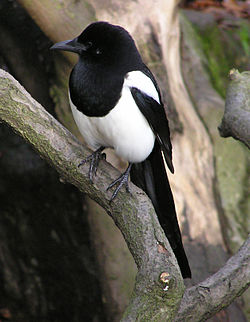Magpie
| Magpies | |
|---|---|
 |
|
| Eurasian magpie | |
| Scientific classification | |
| Kingdom: | Animalia |
| Phylum: | Chordata |
| Class: | Aves |
| Order: | Passeriformes |
| Family: | Corvidae |
| Genera | |
Magpies are birds of the Corvidae (crow) family, including the black and white Eurasian magpie, which is considered one of the most intelligent animals in the world, and the only non-mammal species able to recognize itself in a mirror test (though a recent study suggests that giant manta rays can also recognize their own reflection). In addition to other members of the genus Pica, corvids considered as magpies are in the genera Cissa.
Magpies also found in some region of India i.e Ladakh (Kargil and Leh)
According to some studies, magpies do not form the monophyletic group they are traditionally believed to be—a long tail has certainly elongated (or shortened) independently in multiple lineages of corvid birds. Among the traditional magpies, there appear to be two distinct lineages. One consists of Holarctic species with black/white colouration and is probably closely related to crows and Eurasian jays. The other contains several species from South to East Asia with vivid colouration which is predominantly green or blue. The azure-winged magpie and the Iberian magpie, formerly thought to constitute a single species with a most peculiar distribution, have been shown be two distinct species and classified as the genus Cyanopica.
Other research has cast doubt on the taxonomy of the Pica magpies, since it appears that P. hudsonia and P. nuttalli may not be different species, whereas the Korean race of P. pica is genetically very distinct from the other Eurasian (as well as the North American) forms. Either the North American, Korean, and remaining Eurasian forms are accepted as three or four separate species, or there exists only a single species, Pica pica.
Holarctic (black-and-white) magpies
Oriental (blue/green) magpies
Azure-winged magpies
...
Wikipedia
